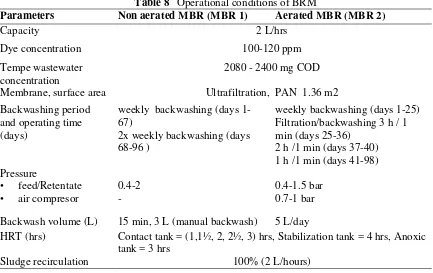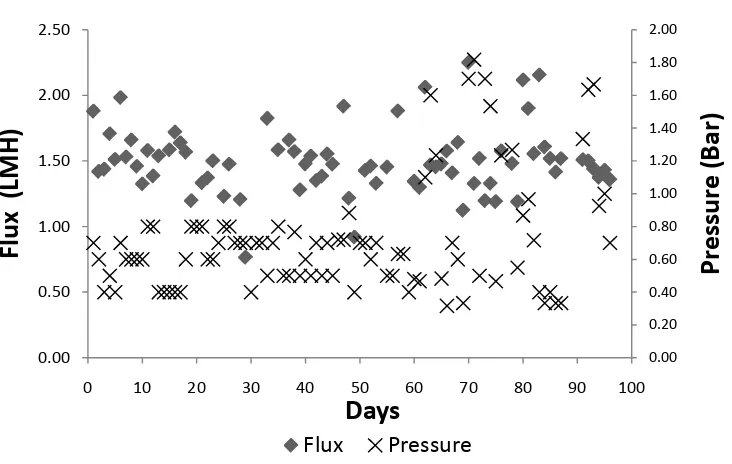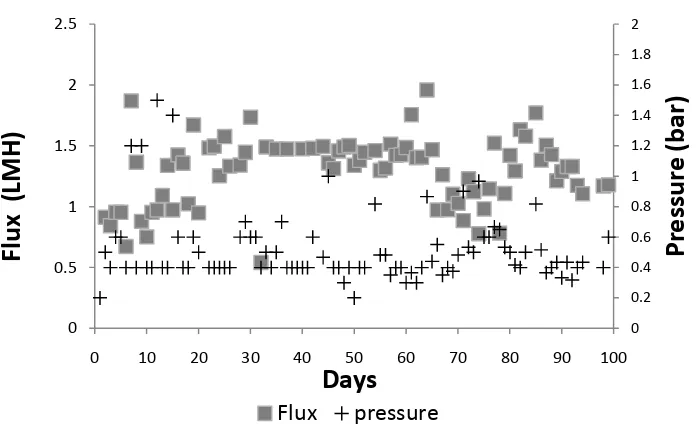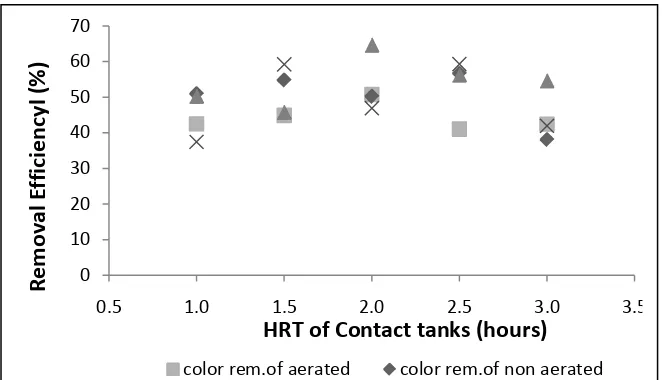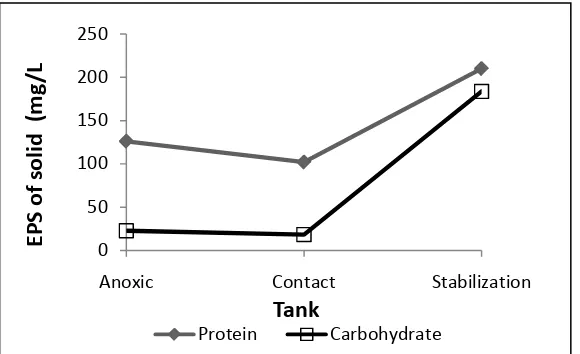Institut Teknologi Bandung, Indonesia 337 29th Nov – 1st Dec 2010
C-10
Performance of anoxic-oxic membrane bioreactor for Azo dye biodegradation 1,2
Puti Sri Komala, 1Agus Jatnika Effendi, 2IG. Wenten, 1Wisjnuprapto
1
Departmentof Environmental Engineering, Institute Technology Bandung
2
Departmentof Environmental Engineering, Andalas University
3
Departmentof Chemical Engineering, Institute Technology Bandung Jalan Ganesha 10 Bandung 40132
Corresponding author:
ABSTRACT
Abstract. A modified activated sludge, contact stabilization process coupled with anoxic reactor and combined with external ultrafiltration membrane is used for azo dye biodegradation. Feed consists of azo dye Remazol Black V and co-substrate tempe industry wastewater as organic source. To obtain the expected HRTs control of the flux stability is required. In this research the performance of two kinds anoxic-oxic membrane bioreactor with and without aeration modes on membrane feed towards flux continuity is studied. Varied HRTs of contact tank in range of 1 to 3 hrs with an half hour increment was performed simultaneously in both reactor for optimum decolorization at constant HRT of anoxic and stabilization tanks i.e. each 4 hrs, It shown that the aeration of the incoming feed between 0.7-1 bar into the membrane combined with fitration and backwash time from 3 hrs-1 min to 1 hr-1 min arrangement allowed to the stable permeate flux. Meanwhile 2 hrs was optimum of the contact hydraulic retention time with 53% and 65% for color - and organics removal and 2.5 hrs was that of the second mode with 57% and 59% for color - and organics removal. Introduction of aeration on membrane feed increased attached biomass on membrane surface, that the aerobic microorganism growth shall utilize the co-substrate lead to increase membrane bioreactor performance. EPSp (protein) presumed played a role on membrane fouling in MBR.
Key words: azo dye, flux, membrane bioreactor, contact stabilization
Introduction
As a relatively new technology membrane bioreactor technology (MBR) is being an alternative process choice in municipal and industrial application (Judd, 2006). Regardless of the wastewater type to be treated, MBR is characterized by high solids removal, a significant disinfection capability, high rate and high efficiency organic and nutrient removal and a small footprint. However, the inevitable decline BRM filtration performance with filtration time. Decrease in flux was accompanied by increased in pressure (TMP) indicate fouling. Fouling according to Koros is a loss of performance of a membrane due to deposition of suspended or dissolved substances on its external surfaces or into its pore (Schäfer, 2005). Many methods have been carried out to reduce fouling. Aeration is so far the most common method to minimize fouling, due to its ability to induce flow circulation and shear stress on the membrane surface. Aeration used in a BRM system has three functions: providing oxygen for biomass, maintaining the activated sludge in suspension and reduce fouling through constant scouring on the membrane surface (Le-Clech et al, 2006). Cleaning strategy both physics and chemistry is another way to remove fouling. Backwashing both by water or permeate pumped in the reverse direction through the membrane was successfully to overcome reversible fouling due to pore blocking and remove part of attached cake layer from the membrane surface.
Institut Teknologi Bandung, Indonesia 338 29th Nov – 1st Dec 2010
are subjected to micro-aerophillic condition dye decolorization is more faster (Padmavaty, 2003). In this experiment anoxic reactor is used prior to the contact-stabilization process in which the double bond of azo chromofor cleaved by aerobic microorganisms which previous aerated and stabilized in the contact-stabilization processes.
In previous research conducted by Komala et al (2008) and Ananthi et al (2008) using the given above MBR configuration for Remazol Black V biodegradation at hydraulic retention time (HRT) anoxic tank in range of ½ hours to 1½ hours and from 1½ to 3 hours, flux declined significant though daily manual backwashing carried out. Fouling was indicated as the TMP exceeds 2 bar and flux dropped even stopped. Experiment by applying manual backwashing was not effective, because it must often be stopped. Based on these results MBR an automatic control of filtration and backwash time was installed. In this research effect of auto backwash to flux stability is compared to that of the manual backwash and varied HRT of contact tank’s of both MBR was performed simultaneously at constant HRT of anoxic-and stabilization tanks. Based on the optimum HRT of the contact, it used for next determining of anoxic and stabilization tanks HRTs for optimum decolorization. Contribution of soluble microbial products (SMP) and extracellular polymeric substances (EPS) in term of proteins and carbohydrates on membrane fouling was observed.
Material and Methods
Microorganisms
A mixed culture was developed from mixed liquor drawn from a textile and dye industry activated sludge treatment plant. The culture was fed with a mixture tempe waste water and 120 mg/L azo dye and aerated batch. This culture will be used for the continuous experiment.
Co-substrate and dye
In decolorization process an external carbon source often has to be added as co substrate due to dye toxicity. Tempe wastewater has a high content of organic carbon and nutrient, required for microbial growth. From the previous batch experiments obtained, the optimum co-substrate concentrations ranging from 2080-2400 mg COD/L tempe industrial waste to the total solution (Komala, 2010). Dye used in this research was reactive azo dye Remazol Black-5 which has a wavelength of 609 nm with concentrations ranging from 100-120 mg/L. Mixed of co-substrate and azo dye Remazol Black-5 is used as feed in the continuous experiment.
Experimental condition
Institut Teknologi Bandung, Indonesia 339 29th Nov – 1st Dec 2010
Figure 8 Scheme of anoxic-oxic membrane bioreactor with aeration on the membrane
In the first reactor, mixed liquor from the contact tank just flowed to the membrane only by a pressure pump without introducing aeration on the membrane feed (non aerated MBR). In the second reactor on the membrane feed air compressor was introduced along with incoming feed from the contact tank (aerated MBR) to allow flow circulating in the membrane lumen. Feed consists of tempe waste water and dye discharged through the pump with a flow rate of 2 L/h into the anoxic reactor which equipped with a mixer with about 40 rpm to mix the solution. Then the mixed liquor flowed by gravity into the contact tank, which equipped with diffuser at the bottom for aeration. From the contact tank the mixed liquor was pumped into the external membrane with operating pressures ranging from 0.4-1.5 bar, produces permeate as filtration product and retentate as concentration of biomass which was then discharged into the tank stabilization. As in the contact tank, at the bottom of stabilization tank a diffuser was mounted for mixed liquor aeration. Pressure gauges mounted at the membrane feed, retentate and permeate streams. Hydraulic retention time (HRT) of stabilization- and the anoxic tanks was kept constant of four and three hours respectively, while HRT of the contact tank varied between (1-3) hours with an half hour increment in both reactors during the experiment. Membrane used was ultrafiltration hollow fiber made from PAN (poly acrylonitrile) having 1.36 m2 membrane area. Membrane was operated in crossflow, in which feedwater flows parallel to the membrane and so expediting the removal of accumulated materials from the membrane. Biomass from stabilization tank recirculated to anoxic tank and mixed with the incoming feed. The permeate flux was calculated periodically from measuring the time taken to collect a known filtrate volume. Adjustment valve was mounted at retentate and permeate stream to set the valve opening. This valve must be set, so that the retentate pressure was not too high which resulted in a small retentate stream while permeate flow was too large.
On the non aerated MBR cleaning by backwashing through the opposite direction from normal flow direction from shell to lumen side using tap water was carried out weekly. Weekly backwashing and no aeration on the membrane feed of the first MBR (non aerated MBR) were conducted during first 67 days. After that twice a week backwashing applied on days 68 to days 96, next day membrane needs to be backwashed daily. In the second MBR a combination of weekly backwashing and providing aeration on the membrane feed was applied from the beginning until days 22. In the
diffuser
STABILIZATION
ANOXIC
Drain
diffuser
Retentate
permeate
backwash
CONTACT
MEMBRANE
Feed tank
S S S S
Compressor Biomass recirculation
Air regulator Motor
Institut Teknologi Bandung, Indonesia 340 29th Nov – 1st Dec 2010
hour-1 min respectively performed on day 23 until day 36, day 37 to day 40 and day 41to the next 98 days respectively. The backwashing interval was controlled by the timer and solenoid valves. Note that backwashing time less than 1 minute with a pressure more than 1 bar cannot be implemented due to the short time of the washing process and membrane strength, so the membrane cleaning was not completed yet while the filtration process had to be started.
Overall operating conditions in reactor 1 and reactor 2 are shown in Table 1.
Analytical methods
Samples from the feed, anoxic, contacts, stabilization tanks, and membrane permeate were collected daily for laboratory measurement. Samples were centrifuged, and then the supernatant was measured for COD by closed reflux method and colors with UV-vis spectrophotometer, while the solids for VSS measurement by gravimetry method. The measurement method used in accordance with the Standard Method of Examination of Water and Waste (APHA, 1995). Soluble microbial product (SMP) of supernatant and extracellular polymeric substances (EPS) of sludge was extracted by heating method proposed by Le-Clech (2006). EPS protein was measured by Lowry and carbohydrate as total reducing sugar by Nelson and Somogyi methods.
Table 8 Operational conditions of BRM
Parameters Non aerated MBR (MBR 1) Aerated MBR (MBR 2)
Capacity 2 L/hrs
Dye concentration 100-120 ppm
Tempe wastewater concentration
2080 - 2400 mg COD
Membrane, surface area Ultrafiltration, PAN 1.36 m2
Backwashing period and operating time (days)
weekly backwashing (days 1-67)
2x weekly backwashing (days 68-96 )
weekly backwashing (days 1-25) Filtration/backwashing 3 h / 1 min (days 25-36)
2 h /1 min (days 37-40) 1 h /1 min (days 41-98) Pressure
• feed/Retentate
• air compresor
0.4-2 -
0.4-1.5 bar 0.7-1 bar
Backwash volume (L) 15 min, 3 L (manual backwash) 5 L/day
HRT (hrs) Contact tank = (1,1½, 2, 2½, 3) hrs, Stabilization tank = 4 hrs, Anoxic tank = 3 hrs
Sludge recirculation 100% (2 L/hours)
Results
Aerated/non aerated MBR
Institut Teknologi Bandung, Indonesia 341 29th Nov – 1st Dec 2010
Figure 9 Flux and pressure on membrane feed of non aerated MBR, at HRT contact (1 to 3) hrs, anoxic and stabilization 3 and 4 hrs, weekly backwashing days 1-67, twice a week backwashing days 68-96)
Flux and pressure data shown here are average values in one treatment condition. In the non aerated MBR with weekly backwashing during the first 25 days the average flux was 1.52 lmh with the average membrane pressure 0.6 bar, from days 26 to days 67 the average flux was reduced to 1.46 lmh with increased membrane feed pressure 0.66 bar. Due to membrane strength this operation could not be continued as the membrane pressure reached 2 bar, then twice a week backwashing applied. Until days 98 the average flux as well as the membrane pressure slightly increased to 1.50 lmh and 0.72 bar. Furthermore applying twice a week membrane backwashing was not sufficient to keep a stable flux and moderate pressure, since the membrane pressure increased significant to 2 bar, so daily backwash had to carry out to increase flux permeate.
Compared to the second MBR operated for a week without aeration on the membrane, the initial flux was 1.78 lmh in average and the low pressure 0.3 bar (data not shown). However this operation could not be prolonged as the membrane pressure increased to more than 1 bar. So, the aeration on membrane combined with weekly backwash operation was implemented in the first 22 days, however the average flux still reduced significant to 1.12 lmh and the average membrane pressure increased to 0.61 bar. A controlling filtration and backwash using a timer was undertaken for the following days. By controlling filtration-backwash time from 3 hrs-1 min, 2 hrs-1 min and 1 hrs-1 min, tend to increase flux in average of 1.36 lmh and 1.42 lmh and 1.32 lmh respectively and average stable membrane pressure 0.5 bar, 0.4 bar and 0.49 bar. Air pressures on the membrane between 0.7 and 1 bar with the membrane feed pressure between 0.4-1 bar were the optimum condition for implementing filtration-backwashing operation. Lowering or increasing of the range of aeration intensity resulted in neither retentate flow nor permeate flow. Nevertheless, aeration on the membrane feed helped expediting the retentate/concentrate stream in the membrane lumen allowed to improve biomass transfer from the contact to the stabilization tank.
Institut Teknologi Bandung, Indonesia 342 29th Nov – 1st Dec 2010
Figure 10Flux and pressure on membrane feed of aerated MBR, at varied HRT of contact (1-3) hrs, anoxic and stabilization 3 and 4 hrs, weekly backwashing days 1-25, Filtration / backwashing 3 h /1 min (days 25-36 ), 2 h /1 min (days 37-40), 1 h /1 min (days 41-100)
Biomass concentration
Biomass concentrations expressed in term of VSS in the non aerated MBR rather higher than that of the aerated (Table 2). Suspended solid concentration in permeate was still quite high, it ranged between 100-300 mg / L resulted low SRT.
Without or with providing of aeration on the membrane did not have a significant influence on the growth of biomass in each reactor. Contact- and stabilization tank of both MBRs had been equipped by the aeration system, thus providing aeration to the membrane did not affected microbial growth in these tanks as long as sufficient dissolved oxygen in bulk. However, the introducing of aeration to the membrane enhanced the oxygen transfer to biomass attached to the membrane which utilized it to degrade substrate. It is corroborated through the organics removal of the aerated MBR greater than that of the non aerated I the next section. Gong (2007) confirmed that the bacteria attached o membrane fibers as a biofilm utilize oxygen transferred directly, so higher biomass concentration helped the MBR achieve better performance.
Table 9 Biomass concentrations
MBR Anoxic (mg VSS /L) Contact (mg VSS /L) Stabilization (mg
VSS /L)
Non aerated 557-1320 457-1046 728-1533
Aerated 393-882 712-877 485-940
Institut Teknologi Bandung, Indonesia 343 29th Nov – 1st Dec 2010
However, the introducing of aeration on the membrane feed enhanced the oxygen transfer utilized by attached biomass on the membrane surface for substrate oxidation. It is corroborated through the organics removal of aerated MBR greater than that of the non aerated MBR in the next section. Gong (2007) confirmed it, that the bacteria attached to the membrane fibers as biofilm utilize oxygen transferred directly, so higher biomass concentrations helped the MBR achieve better performance.
Optimum HRT of contact tank
In figure 4, optimum HRT of contact tank of aerated MBR in range of 1-3 hrs with an half hour time increment was performed at constant HRT of anoxic-and stabilization tanks (3 and 4 hrs) obtained in 2 hrs with 53% and 65% for color- and organics removal, while in the non aerated MBR, 2.5 hrs was the optimum HRT of the contact tank resulted 57% and 59% respectively for color- and organics removal.
In this case the decolorization was still low, presume due to the HRT of the anoxic tank, where the decolorization takes place, had not been optimized yet in both MBRs. In contrast to the color removal the COD removal of the aerated membrane was 72% higher than that of the non aerated MBR i.e. 59%. Direct transfer of oxygen to the biomass attached to the membrane enhanced the biomass growth thus MBR performance in substrate degradation was improved.
Figure 11Optimum HRT of Contact tanks (at HRT of anoxic and stabilization 3 and 4 hrs)
SMP and EPS
Tempe waste water contains high organic compounds and nutrients, even compared to yeast extract some parameters such as COD, BOD, nitrate, K, Na, Mg, Ca, Fe and Al were higher (Komala, 2008), but on the other hand this material presumed responsible for membrane fouling. Fane (2006) stated that in terms of fouling mechanisms, soluble and colloidal materials are assumed to be responsible for the pore blockage of the membrane, while suspended solids account mainly for the cake layer resistance. However, because MBRs are typically operated at medium flux, the formation of biomass cake tends not to occur, but the smaller species (SMP) are much likely to deposit. In figure 5 is shown that the carbohydrates content in SMP from each tank was higher than the protein, meanwhile in the EPS sludge the protein content was higher than carbohydrate content (figure 6). An increase of protein and carbohydrate content occurred after left the membrane (in permeate and stabilization). It is shown that a part of protein exists in solids of bioreactor after that retained by the membrane, which is expected that this plays a role in MBR fouling.
0
Institut Teknologi Bandung, Indonesia 344 29th Nov – 1st Dec 2010
Figure 12EPS of supernatant in the aerated MBR (HRT contact 2 hrs, anoxic and stabilization 3 and 4 hrs)
Figure 13EPS of solids in the aerated MBR (HRT contact 2 hrs, anoxic and stabilization 3 and 4 hrs)
The increased EPS concentration in permeate and stabilization according to poor oxygen transfer within the biofilm structure on the membrane allowed to anaerobic condition which contributed generate a large EPS concentration. Fane (2006) revealed that endogenous decay within the fouling layer was expected the carbohydrate level in the EPS to significant increase. It reported also, the transition between aerobic to anaerobic conditions appears to generate a large amount of EPS, which also play a role in membrane fouling.
Conclusions
Biodegradation of Remazol Black V by using membrane bioreactor anoxic-oxic with non aerated and aerated in the membrane feed capable of generating shear stress on the membrane surface so as to minimize membrane fouling and maintain stable permeate flux. However, the increase in biomass concentration and microbial products in the reactor medium resulted in more frequent cleaning for the non aerated MBR, so the aerated BRM becomes more effective.
The combination of filtration backwashing time from 3 hrs-1min to 1 hr-1min and providing aeration to the membrane feed of 0.7-1 bar had been applied to anoxic-oxic MBR for azo dye biodegradation in the long term operation (98 days) with stable flux without chemical washing. The optimum HRT of contact tank in aerated MBR 2 hours was obtained with color- and organics removal by 53% and 65%, while that of the non aerated MBR was 2.5 hours color- and organics removal of 57% and 59%.
Institut Teknologi Bandung, Indonesia 345 29th Nov – 1st Dec 2010
Providing of aeration on the membrane influence more the organics removal than the color, the biomass attached to the membrane can take advantage of direct oxygen transfer to utilize it for growth and rise, thus the performance of the MBR can be improved. Carbohydrates content in SMP from each tank was higher than protein; meanwhile in the EPS sludge the protein content was higher than carbohydrate content. A part of protein retained by the membrane, which is expected, plays a role in MBR fouling. Transition between aerobic to anaerobic conditions within the fouling layer appears to generate a large amount of EPS, which also play a role in membrane fouling.
Reference
[34] Ananthi, N., Pengaruh waktu detensi hidrolis dalam tangki anoxic terhadap kinerja rangkaian
bioreaktor membran kontak stabilisasi dalam penyisihan zat warna azo Remazol Black V,
Master Thesis, Departmentof Environmental Engineering, Institute Technology Bandung 2008.
[35] American Public Health Association, Standard Methods for the Examination of Water and
Wastewater, A.D. Eaton, L.S. Clesceri, A.E.Greenberg (Eds.), 19th ed., Washington D.C.,
1995.
[36] Brik, M., Schoeberl, P., Chamam B., Braun, R., & Fuchs, W., Advanced treatment of textile
wastewater towards reuse using a membrane bioreactor, Process Biochemistry, 41,1751–
1757, 2006.
[37] Chang, I.S. & Judd, S.J., Air sparging of a submerged MBR for municipal wastewater treatment, Process Biochemistry, 37, 915–920, 2002.
[38] Fane, A.G. & Cho, D., Membrane Bioreactors-Design Options and Operational
Considerations: Fouling Control, Proceedings of Seminar on Membrane Bioreactors and
Hybrid Systems, UTS. Sydney, Australia, 2001
[39] Gong, Z., Yang, F., Liu, S., Bao, H., Hu, S., & Furukawa, K., Feasibility of a membrane-aerated biofilm reactor to achieve single-stage autotrophic nitrogen removal based on
Anammox, Chemosphere, 69, 776–784, 2007.
[40] Judd, S., The MBR book: Principles and Applications of Membrane Bioreactors in Water and Wastewater treatment, Elsevier, 2006.
[41] Komala, P.S., Effendi, A.J., Wenten, I.G., Wisjnuprapto, Pengaruh waktu retensi hidrolis reaktor anoksik terhadap biodegradasi zat warna azo reaktif menggunakan bioreaktormembran aerob-anoksik, Jurnal Teknologi Lingkungan, 4 (4), 91-96, 2008.
[42] Komala, P.S., Effendi, A.J., Wenten, I.G., Wisjnuprapto, Perbandingan Ko-substrat Optimum pada Sistem Batch dan Bioreaktor Membran Anoksik-oksik Kontinu dalam Biodegradasi Zat
Warna Azo, Seminar Teknik Kimia Soehadi Reksowardojo 2010, Bandung, 25-26 Oktober
2010.
[43] Le-Clech, P., Chen, V., Fane ,A.G., Fouling in membrane bioreactors used in wastewater
treatment, Journal of Membrane Science, 284, 17–53, 2006.
[44] Ollgaard, H., Frost ,L., Galster, J. & Hensen, O.C., Survey of Azocolorants on Denmark:
Milgoproject 509, Danish Environmental Protection Agency, 1999
[45] Padmavathy, S., Sandhya, S., Swaminathan, K., Subrahmanyam, Y.V., Chakrabarti, T. & Kaul, S. N., Aerobic Decolorization of Reactive Azo Dyes in Presence of Various Cosubstrates, Chem. Biochem. Eng. Q. 17 ( 2), 147–151, 2003.
[46] Schäfer, A.I., Fane, A.G., & Waite, T.D., Nanofiltration: Principles and Application, ed. by A.I. Schäfer, A.G. Fane, Elsevier Advanced Technology. 2005.
[47] Schoeberl, P., Brik, M., Bertoni, M., Braun, R. & Fuchs, W., Optimization of operational
parameters for a submerged membrane bioreactor treating dyehouse wastewater, Separation

